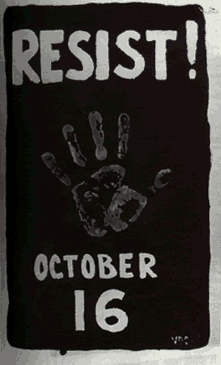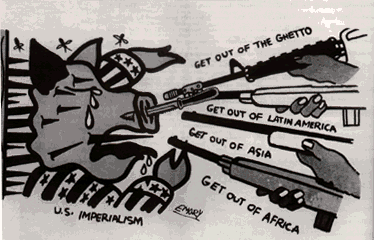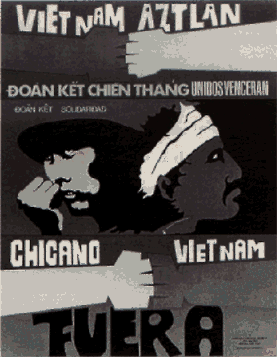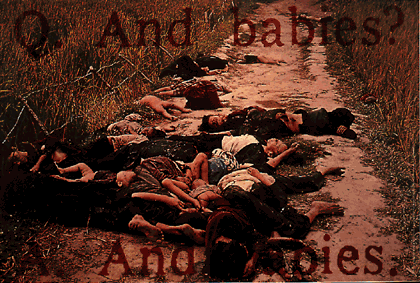|
Chapter summaries
|
Online Chapter: Peace Symbols: Posters in Movements against the Wars in Vietnam and IraqFrom Protest to Resistance, 1967–1969 It is no coincidence that the hippie counterculture peaked during the major years of the antiwar movement. Whether addressed directly or obliquely, the war was on the minds of all young people. By 1965, the United States had two hundred thousand troops in Vietnam. The number of troops needed for the war continued to escalate until a draft became the only way to get enough soldiers to fight the war. In response, antidraft activity had by 1966 become the cutting edge of the progressive movement against the war. The draft greatly upped the stakes for millions of young men (women were not subject to the draft at that time) in the United States, with both idealism and self-preservation driving thousands into draft resistance activism. SNCC and SDS stoked the most militant forms of antidraft work, helping to spur new organizations like Resist and the Resistance, both antidraft groups with strong support from the conscientious objector community of radical pacifists. The key slogan of the era was “From Protest to Resistance,” and resistance clearly meant direct action to disrupt any and all aspects of the war machine. Another, rather less serious, slogan, “Girls Say Yes to Boys Who Say NO!” also found its way onto a widely circulated poster (Figure 19), featuring famous folksinger Joan Baez and her sisters. I have not seen any data as to whether this reverse form of Lysistrata-ism8 was a significant force in the movement, but women in fact played important roles in the draft movement, despite a great deal of sexism. Baez herself made a lifelong commitment to radical pacifism in these years, supporting influential centers for nonviolent study and action such as the still active Resource Center for Nonviolence in Santa Cruz, California. While trivializing and sexist, the slogan offers a backhanded acknowledgment of the crucial roles women played in the peace movement. Despite the sexism endemic in parts of the movement, women were very effective organizers in all the major groups, as well as joining long-standing groups like Women’s International League for Peace and Freedom and Women Strike for Peace. More important, the hundreds of feminist groups emerging in the late 1960s and early 1970s offered tremendous energy to the peace forces.
Figure 19. “Girls Say Yes to Boys Who Say NO!” Courtesy of Sixties Project. The antidraft movement grew rapidly from 1967 to 1969. Actions included individual and collective draft card–burning demonstrations (in one such event more than one thousand young men burned their cards), draft counseling, counterrecruitment for draft resistance and conscientious objection, organizing around and within the military, and direct disruption of draft boards, troop trains, and other elements of the military apparatus. One of the most dramatic of these confrontations occurred as part of a national “Stop the Draft” week in October 1967. At the Oakland, California, military induction center, hundreds of activists, including many vets, shut the center down for hours and engaged in mobile street fighting with the local police over several days (Figure 20).
Figure 20. Vietnam Day Committee, 1967. Courtesy of Sixties Project. As the war continued, Vietnam veterans became some of the most effective antiwar and antidraft activists, their direct experience of the war’s horrors adding credibility to other critiques. Vietnam Veterans Against the War, cofounded by future presidential candidate John Kerry, was the most widespread and effective of these groups. Each new atrocity in Vietnam brought forth a more militant and radical analysis from the antiwar movement. The rise of radical ethnic liberation movements, with groups like such as the Black Panthers (see chapter 2), the Chicano Brown Berets, the Asian American Red Guards, and the Red Power American Indian Movement, included elaboration of anticolonial critique that linked so-called U.S. minority groups to Third World struggles that included solidarity with America’s putative enemies in Vietnam. As in these posters from the Black Panthers (Figure 21) and radical Chicano/a activists (Figure 22), Asian American and Native American activists also linked their struggles against racism to what they saw as a racist war in Vietnam:
Figure 21. Emory Douglas, 1970. Courtesy of Sixties Project. This Third World internationalism also helped drive white radical antiwar and draft resistance groups toward a more explicit identification of the war as an imperialist effort masked by Cold War anticommunist ideologies (much as folks would later accuse the intervention into Iraq of being a war for oil masked as part of the war on terror). The imperialist argument was several steps further than most white middle-class peaceniks wanted to go in the sixties, and it made their protest seem quite mild and reasonable by contrast. With each escalation of the violence of the war, there was an escalation of the violence of graphic resistance. Perhaps the most famous poster of this type was “And babies?” done in the wake of the most horrendous event in the war, the My-Lai massacre in which over five hundred men, women, children, and, yes, babies were killed by U.S. troops under the leadership of Lieutenant William Calley.
Figure 23. “And Babies?” Jon Hendricks, Irving Petlin, and Frazier Dougherty, 1969–70. Photo by Ron Haberle. Courtesy of Sixties Project.
8. Lysistrata is the epononymous heroine in a play by classical Greek dramatist Aristophanes. In an early form of creative antiwar activism, she organizes the women of several Greek cities to refuse sexual relations with their husbands and lovers untilso long as they stopcontinue their warring ways. |
|||





